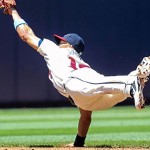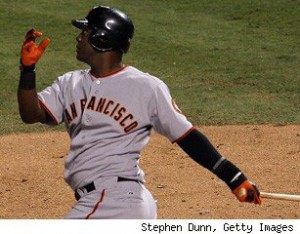
Andrelton Simmons put up what most consider the best defensive season of 2013. Photo via espn.go.com
The recent years have been a rise in all sorts of statistical analysis in the game of baseball (as we all know), and one of the more important areas of research has been the measurement and tracking of defensive metrics. The data we have at our disposal is not yet infallible, but the data has opened our eyes to the real impact that some major leaguers have on the defensive side of the ball.
We’re all quite familiar with the WAR-based arguments that have completely consumed last year’s AL MVP award voting as an example of modern statistics helping to shape the selection of a traditional award winner. However, up until 2013, the Gold Gloves remained an award that was given out without practically any consideration given to any advanced metric, and the awards have been embarassed in recent years with some amazingly inept selections. The two most laughable selections of recent memory were Rafael Palemeiro in 1999 (given a Gold Glove for his play at 1B despite the fact that he only played 28 games in the field that year) and Derek Jeter in 2010 (a year in which he posted a -5.1 UZR/150, was dead last among all 59 AL shortstops in Total Zone Total Fielding and had the selection was openly mocked by the normally staid Baseball-Reference.com website). Even the more defensible gold gloves over the past few years have been considered “wrong” by the stat-crowd, to the point where a number of national writers openly mock the awards and go out of their way to “ignore” th em.
This concerns me as a fan, and as someone who is keenly interested in the Hall of Fame merits of players. I absolutely believe that when it comes time to judge players on the whole of their careers, that individual awards such as the Gold Gloves, MVP and Cy Young awards matter. I want these awards to be relevant and properly awarded.
Two things have happened lately that give me hope:
- Bill James and a varied panel of baseball writers, statisticians in the field and former players now vote on The Fielding Bible awards each year. The 2013 Fielding Bible awards are not league specific; they recognize the best in the majors at each position each year.
- The Gold Glove award committee for the first time in 2013 has incorporated a statistical element to the traditional surveying of players and coaches to choose the award winners.
(All winners/leaders listed below are on one common Google XLS here. Listed are the winners of the GGs, Fielding Bibles, and then the leaders in each league by position of these Defensive stats: UZR/150, DRS, FRAA, and Total Zone. I haven’t gone into the various definitions and pros/cons of these stats; I have a planned off-season defensive statistical overview post where I’ll go into greater detail).
First off, if you believe that the Fielding Bible panel has picked the best possible awardees, then you’ll be happy to note that every Fielding Bible award winner also received a Gold Glove this year. Here’s the Fielding Bible winners by position for 2013:
| Pos | Fielding Bible Winner |
| C | Yadier Molina, STL |
| 1B | Paul Goldschmidt, ARI |
| 2B | Dustin Pedroia, BOS |
| SS | Andrelton Simmons, ATL |
| 3B | Manny Machado, BAL |
| LF | Alex Gordon, KC |
| CF | Carlos Gomez, MIL |
| RF | Gerardo Parra, ARI |
| P | R.A. Dickey, TOR |
Now, here’s the Gold Glove winners, with the Fielding Bible award winners bolded:
| Pos | AL GG Winner | NL GG Winner |
| C | Salvador Perez, KC | Yadier Molina, STL |
| 1B | Eric Hosmer, KC | Paul Goldschmidt, ARI |
| 2B | Dustin Pedroia, BOS | Brandon Phillips, CIN |
| SS | J.J. Hardy, BAL | Andrelton Simmons, ATL |
| 3B | Manny Machado, BAL | Nolan Arenado, COL |
| LF | Alex Gordon, KC | Carlos Gonzalez, COL |
| CF | Adam Jones, BAL | Carlos Gomez, MIL |
| RF | Shane Victorino, BOS | Gerardo Parra, ARI |
| P | R.A. Dickey, TOR | Adam Wainwright, STL |
As you’ll see below by looking at the various defensive metrics out there, most of the Gold Glove winners were merited. In fact, there only seems to be one egregiously bad selection here (which we’ll get to below). Nearly every other winner was at the top of one or more of the advanced metrics available by position for his league:
UZR/150 leaders per league (again, with Fielding Bible winners bolded):
| Pos | AL UZR/150 | NL UZR/150 |
| C | ||
| 1B | Mike Napoli, BOS | Anthony Rizzo, CHC |
| 2B | Ben Zobrist, TBR | Darwin Barney, CHC |
| SS | Yunel Escobar, TBR | Andrelton Simmons ATL |
| 3B | Manny Machado, BAL | Juan Uribe, LAD |
| LF | David Murphy, TEX | Starling Marte, PIT |
| CF | Colby Rasmus, TOR | A.J. Pollack, ARI |
| RF | Shane Victorino, BOS | Gerardo Parra, ARI |
| P |
Defensive Runs Saved leaders per league:
| Pos | AL DRS | NL DRS |
| C | Salvador Perez, KC | Wellington Castillo, CHC |
| 1B | Mike Napoli, BOS | Anthony Rizzo, CHC |
| 2B | Dustin Pedroia, BOS | Darwin Barney, CHC |
| SS | Pedro Florimon, MIN | Andrelton Simmons, ATL |
| 3B | Manny Machado, BAL | Nolan Arenado, COL |
| LF | Alex Gordon, KC | Starling Marte, PIT |
| CF | Leonys Martin, TEX | Carlos Gomez, MIL |
| RF | Shane Victorino, BOS | Gerardo Parra, ARI |
| P |
FRAA Leaders per league:
| Pos | AL FRAA | NL FRAA |
| C | ||
| 1B | Eric Hosmer, KC | Paul Goldschmidt, ARI |
| 2B | Ian Kinsler, TEX | Donovan Solano, MIA |
| SS | Nick Franklin, SEA | Andrelton Simmons, ATL |
| 3B | Manny Machado, BAL | Nolan Arenado, COL |
| LF | Andy Dirks, DET | Carl Crawford, LAD |
| CF | Alejandro De Aza, CWS | Brandon Barnes, HOU |
| RF | Shane Victorino, BOS | Hunter Pence, SF |
| P | R.A. Dickey, TOR | Andrew Cashner, SD |
And lastly here’s the Total Zone Total Fielding leaders:
| Pos | AL Total Zone Total Fielding | NL Total Zone Total Fielding |
| C | Matt Wieters, BAL | Yadier Molina, STL |
| 1B | Mike Napoli, BOS | Paul Goldschmidt, ARI |
| 2B | Dustin Pedroia, BOS | Brandon Phillips, CIN |
| SS | Jayson Nix, NYY | Andrelton Simmons, ATL |
| 3B | Manny Machado, BAL | Juan Uribe, LAD |
| LF | Alex Gordon, KC | Chris Heisey, CIN |
| CF | Jacoby Ellsbury, BOS | Denard Span, WAS |
| RF | Shane Victorino, BOS | Norichika Aoki, MIL |
| P | R.A. Dickey, TOR | Patrick Corbin, ARI |
So, after looking at all these leaders, lets talk a bit about the Gold Gloves and ask ourselves whether they did a good job representing the best defenders this year. Position by position:
Catcher: Salvator Perez is as good an AL pick as any; the only other AL catcher in the mix is Matt Weiters. On the NL side, Jadier Molina has earned his reputation and backs it up on the metrics side. His only challenger being the little known Wellington Castillo from Chicago.
1st Base: Hosmer and Goldschmidt seem as good of picks as any; only Mike Napoli and Anthony Rizzo seemed close in either league. Napoli may have been a better pick than Hosmer on the weight of the evidence.
2nd Base: There’s several decent candidates who were not honored, but I don’t think anyone is arguing vehimently against either Pedroia or Phillips as the winners. Darwin Barney may be the most egreiged candidate.
Shortstop: the amazing Andrelton Simmons led every possible statistical category; there was no chance he was losing. J. J. Hardy‘s selection wasn’t bad per se, but as you can see from the above tables four different AL shortstops led each of the four statistical measures. None of them was Hardy though, making you wonder if his gold glove was slightly on reputation.
3rd Base: One day Manny Machado will move back to short (maybe) and challenge Simmons for the title of “Best Shortstop in the Game.” But for now he has to settle for easily being the best defensive 3B in the game. As with Simmons, Machado led every possible defensive measure at his position. On the NL side, the choice of Nolan Arenado was a sound one, with only Juan Uribe really challenging him. Thankfully the award didn’t go to someone like David Wright or our own Ryan Zimmerman based on reputation.
Left Field: Alex Gordon was a sound choice; the NL choice of Carlos Gonzalez may have been a disservice to one Starling Marte. However, picking individual positions for the OF is somewhat tough, especially for the corners. Fangraphs lists RF winner Gerardo Parra as a left-fielder for some reason.
Center Field: Carlos Gomez is a great pick (and is one of the reasons I posted my “Why no MVP support for Gomez” post in this space, which by the way, got almost no reaction from the readership…). Adam Jones was nearly dead last in some of these range metrics and unfortunately has gotten this award via reputation (and his arm; still one of the best) as opposed to performance. Jones is clearly the “Derek Jeter” of 2013, and the voters really erred badly on his selection. Its hard for me to say who I would have preferred; Jacoby Ellsbury is the biggest name among the four guys who led the four different defensive numbers, but Ellsbury’s arm is weak (nearly last of any CF in the league) and a better candidate would have been Leonys Martin.
Right Field: Gerardo Parra and Shane Victorino are the leading candidates for their leagues and both selections are warranted. I know that Hunter Pence led the NL in FRAA, but his arm is awful (one of the worst of any RF in the league), so that has to count against him. In fact, Victorino was as good as or better than Parra in most of these metrics (with the exception of Arm; Parra has one of the better arms in the league). I’m guessing its arm strength that tipped the Fielding Bible balance to Parra.
—
Conclusion: I think the Gold Gloves did a pretty good job in 2013 of identifying the best overall defenders at each position. With one significant exception (Adam Jones). I think its time the sportswriters who have been purposely ignoring the awards come back into the fold.
